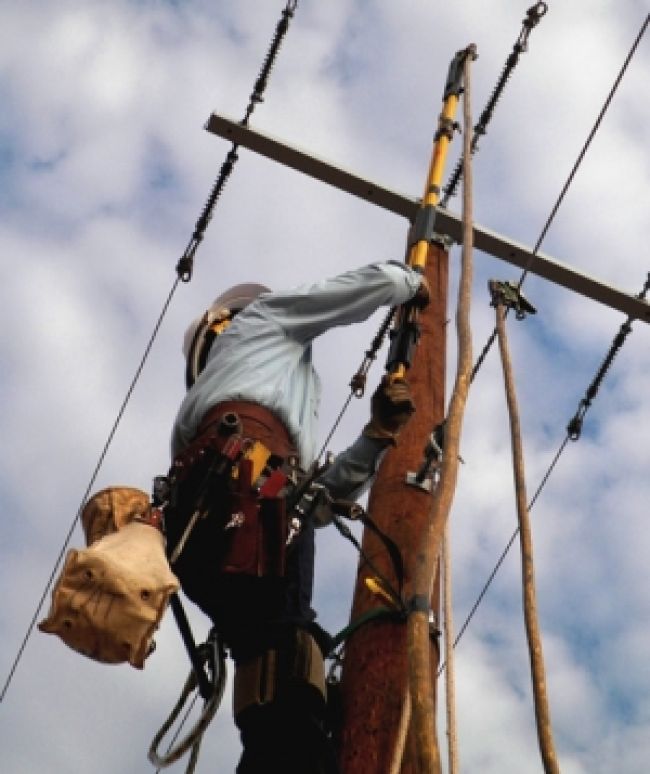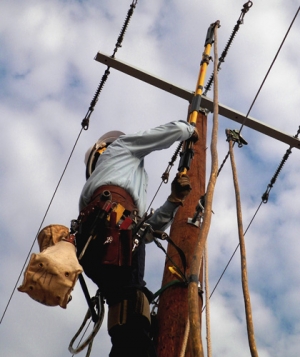
Transitioning to FR Clothing

Since Tacoma Power’s creation in the 1890s, its employees have worked on or around energized conductors and have been exposed to the hazards of electrical arcs and flames. For most of that time, electrical workers wore natural fiber clothing to reduce the risk of injury if involved in a situation that could result in an arc flash. Injuries from burning clothing can lead to permanent disabilities and death.
The utility launched a project in 2009 to transition to protective clothing that would provide an even greater level of protection. Flame-resistant (FR) clothing promised a much higher level of employee safety, as it is designed to self-extinguish when ignited rather than continue to burn, which is possible with natural fiber clothing.
Getting the Ball Rolling
The first step in this transition was to gather as much information as possible about electrical arcs and the protective clothing products available. Key employees involved in the process attended training classes and soon learned this topic can be complex and confusing. It seemed that there were as many different opinions on what was required as there were industry experts. Sorting out the National Electrical Safety Code rules from the National Fire Protection Association rules turned out to be a huge task. While both contained useful information for reducing potential employee injury, the requirements of each varied greatly.
Reaching out to other utilities with existing FR clothing programs proved invaluable to determine what rules would apply to our program. Avista Utilities in Spokane, Wash., provided great guidance and insight about how they had established their FR clothing program and shared much of their experience in conducting an arc flash study. With an understanding of the core program requirements, it was time to explore what protective clothing was available.
We requested information from FR clothing providers and received an overwhelming response. I had no idea there were so many fabrics, styles and types of garments available. We learned about arc thermal performance value (ATPV) ratings, calories, arc flash boundaries and clothing layering.
The transmission and distribution management team oversaw the development of an FR policy to provide clear direction on how we would develop, implement and oversee the FR clothing program. This written policy was useful in maintaining consistency and vision as we made program development decisions. One of the early policy decisions was that our field crews would be required to wear 8-calorie FR clothing whenever they are at work. This decision was based on a review of industry best practices and a desire to provide FR protection in all work situations.
One of the policy decisions we had to make was what type of FR program we would have: direct clothing replacement or clothing allowance. In a direct replacement program, workers are given protective clothing that is replaced as it wears out. In an allowance program, employees are given a credit with the FR clothing provider and select clothing from a catalog. Replacement clothing is covered by an annual allowance. Both programs have their advantages and disadvantages, and we had to weigh the pros and cons. We ultimately decided on a direct replacement program. In addition to the normal requirements of overseeing the FR clothing program, the management of a direct replacement program requires staff time to manage employee orders, deal with order problems and deliver the clothing to employees when it is received from the vendor.
Picking Up Speed
With the policy and work practice in development, it was time to ask our employees to assist in evaluating FR clothing options. We conducted a wear test over a three-month period using clothing from various suppliers and manufacturers. The test included workers from the work groups that would soon be wearing FR clothing on a daily basis. The results of the test were encouraging, with only a few garments that were unacceptable. One area that was particularly challenging was identifying FR clothing options for our female workers. Women’s clothing makes up only a small part of the FR clothing available, and it took a great deal of time to find clothing options to meet the needs of all of our employees.
With the information provided by the wear test, we created a request for proposal to select a vendor to provide our FR clothing under a multiyear clothing replacement contract. After an extensive evaluation process, we selected a vendor. The vendor performed on-site fittings for each of our employees who would be required to wear FR clothing. When the clothing arrived, we spent time adjusting sizes and working with employees to make sure the clothing fit properly. Like any project of this complexity, we had rough spots that required adjustments and the addition of clothing choices to meet the specific needs of some workers.
Employee training was a key part of the implementation process. For FR clothing to maintain its protective qualities, it is important that it is properly laundered and cared for. Employees learned the limitations of the clothing and how to determine what clothing needs to be worn in what situations. We worked with a consultant who provided a train-the-trainer program and helped us to tailor the training to our needs.
Our engineering department undertook an arc flash study that focused on our electrical system and the work practices used at our utility. The results of the study were then incorporated in a written work practice to provide guidance to workers in any situation on any part of our electrical system. Workers received specific training on this work practice.
Rolling Along
Since the implementation of the Daily Wear FR Program, we have had three arc flash incidents during which the protective clothing was being worn. All involved secondary voltages and resulted in minor burns to exposed skin. In each case, the FR clothing performed as expected. In one incident, the fabric of a pair of FR pants experienced breakthrough and the arc ignited the top of a non-FR sock the employee was wearing. The burning sock did cause a small, painful burn for the worker. It is important to remember that even when FR clothing is worn properly, workers can receive burns to exposed skin or experience failure of the fabric by exposure to arc flash levels above its ratings. Always match the rating of the FR clothing to the possible energy exposure.
The program has now reached a maintenance phase where we primarily work on replacing clothing that has worn out or been damaged during the course of work. We regularly adjust the clothing choices to replace items that are no longer available. Quarterly meetings with our vendor help us stay up to speed on clothing that may have changed or is no longer available. For example, the availability of fabrics to the vendor has a direct impact on what clothing may be available to us. Increased popularity of FR clothing has increased some delivery times and, as a result, replacement clothing is now ordered much sooner than when the program first started.
The creation, implementation and oversight of an FR clothing program requires a great deal of planning, education and attention to detail, but it can make all the difference when a worker is involved in an arc flash incident. Preventing arc flash injuries requires everyone involved to do everything possible to avoid the complacency that may creep in when your program is rolling along.
About the Author: Jim Boyd, CUSP, is the transmission and distribution manager at Tacoma Power. He has more than 35 years of high-voltage experience through his work with investor-owned utilities, municipal utilities and a contractor company.
Sidebar: Considerations When Starting Your FR Program
• Remember that change is hard, especially if there is no perceived need for it by the end-users.
• Be prepared for pushback and, in some cases, employee dissatisfaction.
• Become as knowledgeable as you can on the subject to help make decisions that improve worker safety.
• Conduct training. For those who use it, your program is only as good as the training provided.
• Reach out to others and form partnerships with industry experts who can assist you. Consultants and vendors can be quite helpful. If you receive conflicting information, continue to research.
• Be prepared to evaluate the arc flash risk level posed by your system in order to select the proper clothing and set the proper use policies.
• Remind yourself that an FR clothing program is ongoing and will require updates as work practices and technology change.

